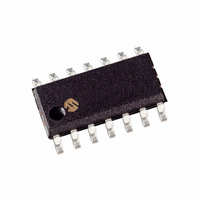MCP6144-I/SL Microchip Technology, MCP6144-I/SL Datasheet - Page 12

MCP6144-I/SL
Manufacturer Part Number
MCP6144-I/SL
Description
IC OPAMP 1.4V QUAD R-R 14-SOIC
Manufacturer
Microchip Technology
Specifications of MCP6144-I/SL
Slew Rate
0.003 V/µs
Operating Temperature
-40°C ~ 85°C
Amplifier Type
General Purpose
Number Of Circuits
4
Output Type
Rail-to-Rail
Gain Bandwidth Product
100kHz
Current - Input Bias
1pA
Voltage - Input Offset
3000µV
Current - Supply
0.6µA
Current - Output / Channel
20mA
Voltage - Supply, Single/dual (±)
1.4 V ~ 6 V
Mounting Type
Surface Mount
Package / Case
14-SOIC (3.9mm Width), 14-SOL
Op Amp Type
General Purpose
No. Of Amplifiers
4
Bandwidth
100kHz
Supply Voltage Range
1.4V To 5.5V
Amplifier Case Style
SOIC
No. Of Pins
14
Number Of Channels
4
Voltage Gain Db
115 dB
Common Mode Rejection Ratio (min)
60 dB
Input Offset Voltage
3 mV
Operating Supply Voltage
3 V, 5 V
Supply Current
0.004 mA
Maximum Operating Temperature
+ 85 C
Mounting Style
SMD/SMT
Minimum Operating Temperature
- 40 C
Lead Free Status / RoHS Status
Lead free / RoHS Compliant
-3db Bandwidth
-
Lead Free Status / Rohs Status
Details
Available stocks
Company
Part Number
Manufacturer
Quantity
Price
Company:
Part Number:
MCP6144-I/SL
Manufacturer:
MICROCHIP
Quantity:
12 000
MCP6141/2/3/4
4.0
The MCP6141/2/3/4 family of op amps is manufactured
using Microchip’s state-of-the-art CMOS process
These op amps are stable for gains of 10 V/V and
higher. They are suitable for a wide range of general
purpose, low-power applications.
See Microchip’s related MCP6041/2/3/4 family of op
amps for applications needing unity gain stability.
4.1
The MCP6141/2/3/4 op amps are designed to prevent
phase reversal when the input pins exceed the supply
voltages. Figure 2-10 shows the input voltage exceed-
ing the supply voltage without any phase reversal.
The input stage of the MCP6141/2/3/4 op amps uses
two differential CMOS input stages in parallel. One
operates at low Common mode input voltage (V
while the other operates at high V
ogy, the device operates with V
and 0.3V below V
measured at V
ensure proper operation.
Input voltages that exceed the Absolute Maximum Volt-
age Range (V
excessive current to flow into or out of the input pins.
Current beyond ±2 mA can cause reliability problems.
Applications that exceed this rating must be externally
limited with a resistor, as shown in Figure 4-1.
FIGURE 4-1:
Resistor (R
4.2
There are two specifications that describe the output
swing capability of the MCP6141/2/3/4 family of op
amps. The first specification (Maximum Output Voltage
Swing) defines the absolute maximum swing that can
be achieved under the specified load condition. Thus,
the output voltage swings to within 10 mV of either sup-
ply rail with a 50 k
how the output voltage is limited when the input goes
beyond the linear region of operation.
DS21668B-page 12
V
V
A
B
APPLICATIONS INFORMATION
Rail-to-Rail Inputs
Rail-to-Rail Output
R
R
IN
IN
IN
R
R
).
------------------------------------------------------------------------------
IN
SS
IN
V
-------------------------------------------------------------------------- -
Maximum expected V
CM
SS
SS
– 0.3V to V
–
= V
. The input offset voltage (V
load to V
Minimum expected V
Input Current-Limiting
MCP614X
SS
– 0.3V and V
2 mA
2 mA
R
F
DD
CM
DD
/2. Figure 2-10 shows
tp to 0.3V above V
+ 0.3V) can cause
CM
IN
. With this topol-
–
V
DD
IN
DD
V
OUT
+ 0.3V to
OS
CM
) is
DD
),
The second specification that describes the output
swing capability of these amplifiers is the Linear Output
Voltage Range. This specification defines the maxi-
mum output swing that can be achieved while the
amplifier still operates in its linear region. To verify
linear operation in this range, the large signal DC
Open-Loop Gain (A
supply rails. The measurement must meet the specified
A
4.3
The MCP6141/2/3/4 op amp family has outstanding
quiescent current, which supports battery-powered
applications. There is minimal quiescent current glitch-
ing when Chip Select (CS) is raised or lowered. This
prevents excessive current draw, and reduced battery
life, when the part is turned off or on.
Heavy resistive loads at the output can cause exces-
sive battery drain. Driving a DC voltage of 2.5V across
a 100 k
increase by 25 A, depleting the battery 43 times as
fast as I
High frequency signals (fast edge rate) across capaci-
tive loads will also significantly increase supply current.
For instance, a 0.1 F capacitor at the output presents
an AC impedance of 15.9 k (1/2 fC) to a 100 Hz sin-
ewave. It can be shown that the average power drawn
from the battery by a 5.0 V
under these conditions, is
EQUATION 4-1:
This will drain the battery 18 times as fast as I
4.4
4.4.1
The MCP6141/2/3/4 op amp family is designed to give
high bandwidth and slew rate for circuits with high noise
gain (G
be realized using the MCP6041/2/3/4 op amp family;
this simplifies design and implementation issues.
Noise gain is defined to be the gain from a voltage
source at the non-inverting input to the output when all
other voltage sources are zeroed (shorted out). Noise
gain is independent of signal gain and depends only on
components in the feedback loop. The amplifier circuits
in Figure 4-2 and Figure 4-3 have their noise gain
calculated as follows:
OL
P
Supply
condition in the specification table.
N
Q
) or signal gain. Low gain applications should
Output Loads and Battery Life
Stability
load resistor will cause the supply current to
(0.6 A, typ.) alone.
= (V
= (5V)(0.6 µA + 5.0V
= 3.0 µW + 50 µW
NOISE GAIN
DD
- V
OL
SS
) is measured at points inside the
) (I
© 2005 Microchip Technology Inc.
Q
+ V
p-p
L(p-p)
p-p
sinewave (1.77 V
·
100Hz
f C
L
)
·
0.1µF)
Q
alone.
rms
),















